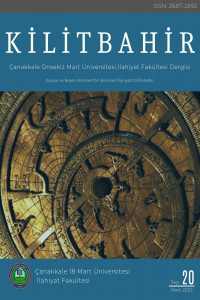Meryem’in Hristiyanlıktaki Konumuna Katolik ve Protestan Bakışı
Dinler Tarihi, Meryem, Katoliklik, Protestanlık, Ebedi Bakirelik, Günahsızlık, Şefaat, Göğe Yükseliş
Catholic and Protestant Perspective on the Position of Mary in Christianity
History of Religions, Mary, Catholicisim, Protestanism, Eternal Virginity, Sinlessness, İntercession, Ascension,
___
- Akalın, Kürşad Haldun, “Orta Çağın Hristiyanlık Öğretisinde Meryem Ana Yüceltmesi”, Atatürk Üniversitesi İlahiyat Fakültesi Dergisi, 27, (2007), 271-305.
- Akalın, Kürşad Haldun, “Göğün Kraliçesi İsis’in Geri Dönüşü: Hristiyanlıkta Meryem Ana Tapınması”, Atatürk Üniversitesi İlahiyat Fakültesi İlahiyat Tetkikleri Dergisi (İLTED), 45, (2016), 81-107.
- Alıcı, Mustafa, “Kur’an-ı Kerim ve Katolik Meryem Teolojisi (Mariology ve Kur’an-ı Kerim” Akra Kültür Sanat ve Edebiyat Dergisi, 9, (2016), 103-115.
- Aquines, Thomas, Summa Teologiae, Edited by Anton C. Pegis, New York: Random House 1944.
- Aydın, Mehmet, “I. İznik (M.S. 325) ve Efes (M.S. 431) Konsilleri Doğrultusunda Hristiyanlık’ta Hz. Meryem Kültü’nün Gelişimi”, Türk-İslam Medeniyeti Akademik Araştırmalar Dergisi = Journal of the Academic Studies of Turkish-Islamic Civilization, 20, (2015), 9-18.
- Boyer, Marie France, The Cult of Virgin: Offerings, Ornaments and Festivals, London: Thames&Hudson 2000.
- Carol, J. B, “Mediatrix of Graces” New Catholic Encyclopedia, 9/258-260, Farmington Hills: Thomson Gale 2003.
- Carroll, E. R, “Mary, Blessed Virgin, Devotion To” New Catholic Encyclopedia, (Second Edition), 9/282-283, Farmington Hills: Thomson Gale 2003.
- Cooper, James, ''Mary" Encyclopedia of Religion and Ethics, Ed. James Hastings, 8/474-480, Edinburgh: T&T Clark 1916.
- Davies, Rupert E., The Problem of Authority in the Continantal Reformers, London: The Epworth Press, 1946.
- Dodd, Gloria Falcão, The Virgin Mary, Mediatrix of All Grace (History and Teology of The Movement for a Dogmatic Definition From 1896-1964) New Berford: Academy of İmmaculate 2012.
- Durant, Will, The Reformation: A History of European Civilization from Wycliffe to Calvin 1300-1564, New York: Simon and Schuster 1957.
- Dvornik, Francis, Konsiller Tarihi, İznik’ten II. Vatikan’a, Çeviren: Prof. Dr. Mehmet Aydın, Ankara: Türk Tarih Kurumu Yayınları 1990.
- Fidan, Maksude Kurt, “Ana Tanrıçalardan Bakire Meryem’e Kadının Mitolojik Öyküsü”, II. Türkiye Lisansüstü Çalışmalar Kongresi Bildiriler Kitabı - IV (6-8 Mayıs 2013, Bursa), 927-944, 2013.
- Geisler, Norman L. and Ralpha E. Mackenzie, Roman Catholics and Evangelicals Agreements and Differences, United State of America: Baker Books 2004.
- Hackett, Helen, Virgin Mother, Maiden Queen: (Elizabeth I and the Cult of Virgin Mary), Newyork: St. Martin's Press 1995.
- Harman, Ömer Faruk, “Meryem”, Türkiye Diyanet Vakfı İslam Ansiklopedisi, 29/236-241, Ankara: Türkiye Diyanet Vakfı Yayınları 2004.
- Johnson, E.A, “Mary (In Catholic-Protestant Dialogue)”, New Catholic Encyclopedia, 9/283-284, Farmington Hills: Thomson Gale 2003.
- Kaçar, Turhan, “Ebioniteler’den Arius’a: Eskiçağ Doğu Hristiyanlığında İsa Teolojisi Tartışmaları”, Ankara Üniversitesi İlahiyat Fakültesi Dergisi, 44/2, (2003), 187-206.
- Kutsal Kitap, İstanbul: Kitabı Mukaddes Şirketi Yayınları 2010.
- Lampe, Geoffrey William Hugo, "Christian Theology in the Patristic Period", in A History of Christian Doctrine, ed. Huber Cunliffe Jones, Edinburgh: T&T Clark 1997.
- Olgun, Hakan, Luther ve Reformu Katolisizm’i Protesto, İstanbul: Eski Yeni Yayınları 2006.
- Ott, Ludwig, Fundamentals of Catholic Dogma, Edited by James Canon Bastible, Translated by Patric Lynch, III, Rockford: Tan Books and Publisher 1960.
- Reumann, John, "Mary", Encyclopedia of Religion, Second Edition, Ed.: Lindsay Jones, 9/5753-5754, Farmington Hills: Thomson Gale 2005.
- Rouillard, P. - T. Krosnicki, “Marian Feasts”, New Catholic Encyclopedia, 9/157-159, Farmington Hills: Thomson Gale 2003.
- Tarakçı, Muhammet, “St. Thomas Aquinas’a Göre Aslî Günah”, Uludağ Üniversitesi İlahiyat Fakültesi Dergisi, Cilt: 15, Sayı:1, s. 307-318, Bursa 2006.
- Tümer, Günay, Hristiyanlıkta ve İslam’da Hz. Meryem, Türkiye Diyanet Vakfı Yayınları, Ankara 1997.
- Vollert, C. O. - Jelly F. M., “Mary and The Church”, New Catholic Encyclopedia, (Second Edition), 9/255, Farmington Hills: Thomson Gale 2003.
- Yitik, Ali İhsan, “Hz. Meryem ve Efes-Meryemana Evi”, Fırat Üniversitesi İlahiyat Fakültesi Dergisi, [Prof. Dr. Şaban Kuzgun Armağanı], 5, Elazığ 2000.
- Yayın Aralığı: Yılda 2 Sayı
- Başlangıç: 2012
- Yayıncı: Çanakkale Onsekiz Mart Üniversitesi
Nahivcilerin Bazı Morfolojik Zarûretlere Dair Yaklaşımları
Zerdüştlükte Tanrı-Evren İlişkisi Bağlamında Meleklerin Rolü
Fahreddin er-Râzî’nin Tefsiri Mefâtîhu’l-Gayb’a Kıraatlerin Sıhhat Şartları Açısından Bir Bakış
Türkiye’de Seyyid Kutub’la ilgili Yapılan Akademik Çalışmalar: (Yüksek Lisans ve Doktora Tezleri)
Modernliğin Arkeolojisi (Foucault) ve Postmodernliğin Arkeolojisi (Baudrillard)
Bir Şârihin İlmî Kişiliğini Tetkik Etmek: İbn Abdülber ve Muvatta’ Hakkındaki Şerhleri
Meryem’in Hristiyanlıktaki Konumuna Katolik ve Protestan Bakışı
Mâtürîdî’nin Te’vîlât’ı Çerçevesinde Kur’ân’da Varlık Türleri Arasındaki Üstünlük Meselesi
Distopyalarda Ahlakın Devlet Düzenindeki Yeri
